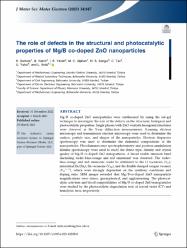| dc.contributor.author | Şentürk, Kenan | |
| dc.contributor.author | Yalçın, Bestenur | |
| dc.contributor.author | Yalçın, İbrahim Ertuğrul | |
| dc.contributor.author | Alphan, Mehmet Can | |
| dc.contributor.author | Şengül, Merve Şazimet | |
| dc.contributor.author | Tav, Cumali | |
| dc.contributor.author | Yahşi, Uğur | |
| dc.contributor.author | Arda, Lütfi | |
| dc.date.accessioned | 2023-04-24T11:56:11Z | |
| dc.date.available | 2023-04-24T11:56:11Z | |
| dc.date.issued | 2023 | en_US |
| dc.identifier.issn | 0957-4522 | |
| dc.identifier.issn | 1573-482X | |
| dc.identifier.uri | https://hdl.handle.net/11363/4498 | |
| dc.description.abstract | Mg/B co-doped ZnO nanoparticles were synthesized by using the sol–gel
technique to investigate the role of the defects on the structural, biological and
photocatalytic properties. Single phases with ZnO wurtzite hexagonal structures
were observed in the X-ray diffraction measurements. Scanning electron
microscopy and transmission electron microscopy were used to determine the
surface, particle size, and shapes of the nanoparticles. Electron dispersive
spectroscopy was used to determine the elemental compositions of the
nanoparticles. Photoluminescence spectrophotometry and positron annihilation
lifetime spectroscopy were used to study the defect type, density and crystal
quality of Mg/B co-doped ZnO nanoparticles. A broad visible emission band
(including violet–blue-orange and red emissions) was observed. The violet–
blue-orange and red emissions could be attributed to the O vacancies (VO),
interstitial Zn (Zni), Zn vacancies (VZn), and the double charged oxygen vacancy
(VO
(??)
), which were strongly dependent on the synthesis conditions and
doping ratio. SEM images revealed that Mg/B-co-doped ZnO nanoparticle
magnifications were dense, quasispherical, and agglomerating. The photocatalytic activities and blood compatibilities of Mg/B co-doped ZnO nanoparticles
were studied by the photocatalytic degradation tests of crystal violet (CV) and
hemolysis tests, respectively. | en_US |
| dc.language.iso | eng | en_US |
| dc.publisher | SPRINGER, VAN GODEWIJCKSTRAAT 30, 3311 GZ DORDRECHT, NETHERLANDS | en_US |
| dc.relation.isversionof | https://doi.org/10.1007/s10854-023-10208-0 | en_US |
| dc.rights | info:eu-repo/semantics/openAccess | en_US |
| dc.rights | Attribution-NonCommercial-NoDerivs 3.0 United States | * |
| dc.rights.uri | http://creativecommons.org/licenses/by-nc-nd/3.0/us/ | * |
| dc.subject | OXIDE THIN-FILMS | en_US |
| dc.subject | ZINC-OXIDE | en_US |
| dc.subject | FREE-VOLUME | en_US |
| dc.subject | ANTIBACTERIAL ACTIVITY | en_US |
| dc.subject | ELECTRICAL-PROPERTIES | en_US |
| dc.subject | OPTICAL-PROPERTIES | en_US |
| dc.subject | METHYLENE-BLUE | en_US |
| dc.subject | DEGRADATION | en_US |
| dc.subject | NANOCOMPOSITE | en_US |
| dc.subject | MORPHOLOGY | en_US |
| dc.title | The role of defects in the structural and photocatalytic properties of Mg/B co-doped ZnO nanoparticles | en_US |
| dc.type | article | en_US |
| dc.relation.ispartof | Journal of Materials Science: Materials in Electronics | en_US |
| dc.department | Mühendislik ve Mimarlık Fakültesi | en_US |
| dc.authorid | http://orcid.org/0000-0003-0722-3891 | en_US |
| dc.identifier.volume | 34 | en_US |
| dc.identifier.issue | 9 | en_US |
| dc.identifier.startpage | 1 | en_US |
| dc.identifier.endpage | 22 | en_US |
| dc.relation.publicationcategory | Makale - Uluslararası Hakemli Dergi - Kurum Öğretim Elemanı | en_US |



















